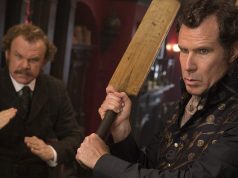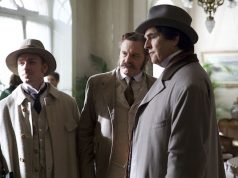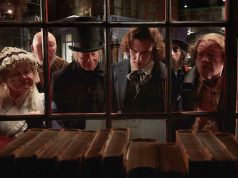Is “Topsy-Turvy” a vivid, realistic, detail-perfect re-creation of the Victorian theater world? Yes. Will anyone other than Gilbert & Sullivan fans enjoy it? That is the question.
At 2 hours and 40 minutes, it stretches the patience of any movie-goer, G&S fan or not. And a good 30 minutes, total, are devoted to showing bits of performances of the duo’s comic operas. Anyone not especially interested in such things is unlikely to be won over, as the performances are nothing spectacular. They’re realistic according to the period (the 1880s, in London), but do not exude excitement. They hardly even capture the humor G&S were known for. (One could watch these segments and wonder how, exactly, anyone ever thought these queer little musicals were comedies.)
I do like Gilbert & Sullivan quite a bit, and am a fan of theater history, too. Yet even I found myself wishing the film were shorter and more to the point.
“Topsy-Turvy” takes place at a critical juncture in William S. Gilbert (Jim Broadbent) and Sir Arthur Sullivan’s (Allan Corduner) career together. Though partners for over two decades and having great respect for one another’s talents, the two are not friends, socially, and have little in common. Gilbert (who wrote the words) is a sarcastic, stuffy man, while Sullivan (the composer) is a hedonistic man-about-town. They call each other “Gilbert” and “Sullivan,” even while others use their first names.
Still, they have worked well together and have become THE names in the theater world. As the film begins, though, their latest work, “Princess Ida,” is opening to poor reviews and, eventually, poor attendance. Furthermore, the libretto Gilbert has written for their next project proves absolutely unsuitable to Sullivan, who says he’s tired of writing such trivial music for trivial shows. He wants to write a grand opera; his contract with Richard D’Oyly Carte (Ron Cook) and the Savoy Theatre is the only thing keeping him in operettas.
Then Gilbert is dragged by his wife, Lucy (Lesley Manville), to a Japanese-culture exhibit currently in London. He is inspired by it and comes up with “The Mikado.” The rest of the movie shows the politics, struggles and backstage bickering that goes into producing a show. Actresses don’t want to wear traditional Japanese costumes because it means they can’t wear their corsets. Sullivan is still unhappy with writing fluff. Gilbert continues his tradition of refusing to attend opening-night performances, largely because he doesn’t know how to take praise, and is unsure whether he even deserves it.
Broadbent and Corduner are fantastic as Gilbert and Sullivan, fleshing out their characters to the point of making them as tangible as the guy sitting next to you. The creative process is often fascinating to watch, and director/writer Mike Leigh often lets the camera sit in one spot for minutes at a time to let us enjoy the experience as if we were live spectators.
What the film lacks, though, is a conclusion; it’s not really meant to have one. The whole point is to be a period piece, a historical drama (with some comedy) meant to depict Victorian theater life. This is done extraordinarily well. What it does not do is leave the viewer with any satisfaction on the level one normally expects at the movies. It’s easy to say the film is highbrow and artistic, which it certainly is, but that doesn’t necessarily excuse it from its obligation to entertain. Not that a film must pander, but indeed, who goes to the movies just for a history lesson? Theater buffs will rejoice in the film’s splendid re-creation of a marvelous period in theater history. Others will no doubt find the film over-long and under-cooked.
B (; )





